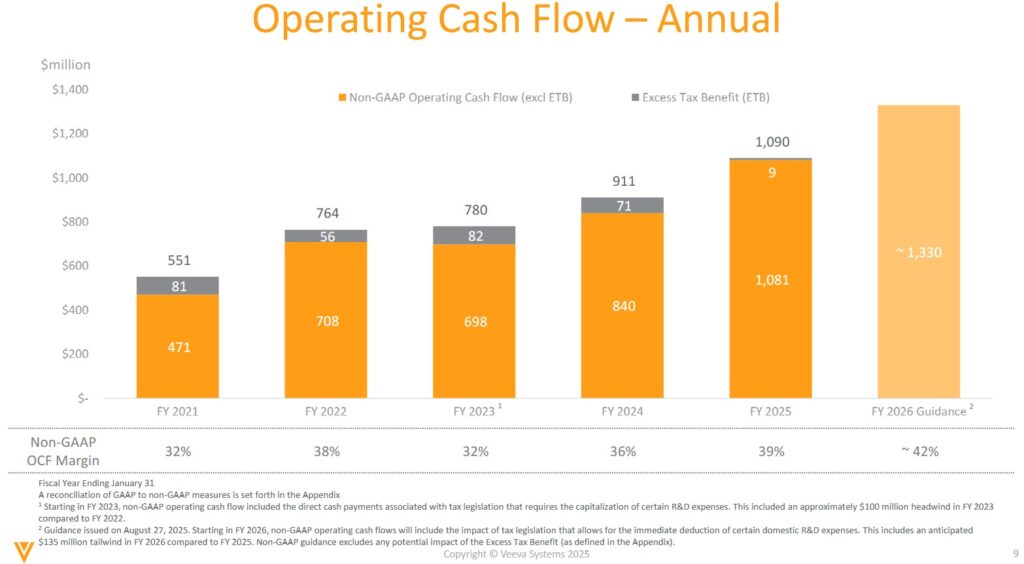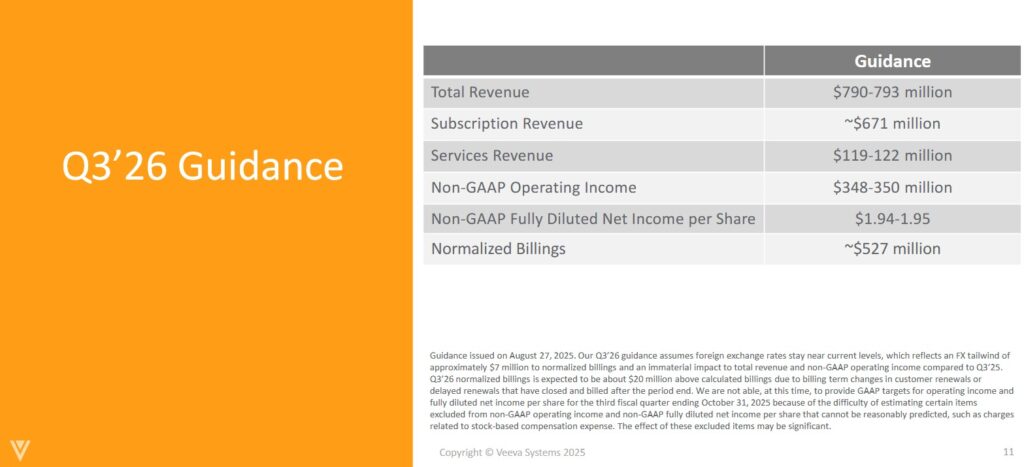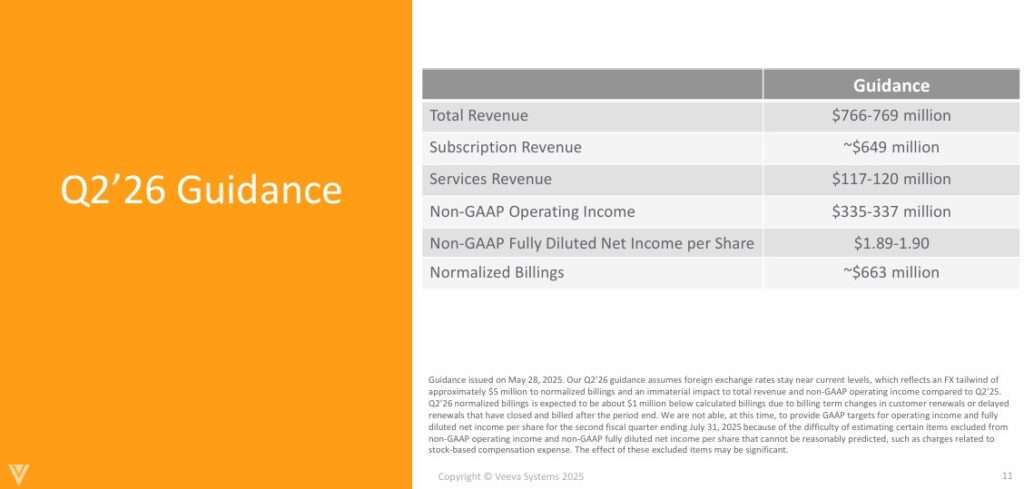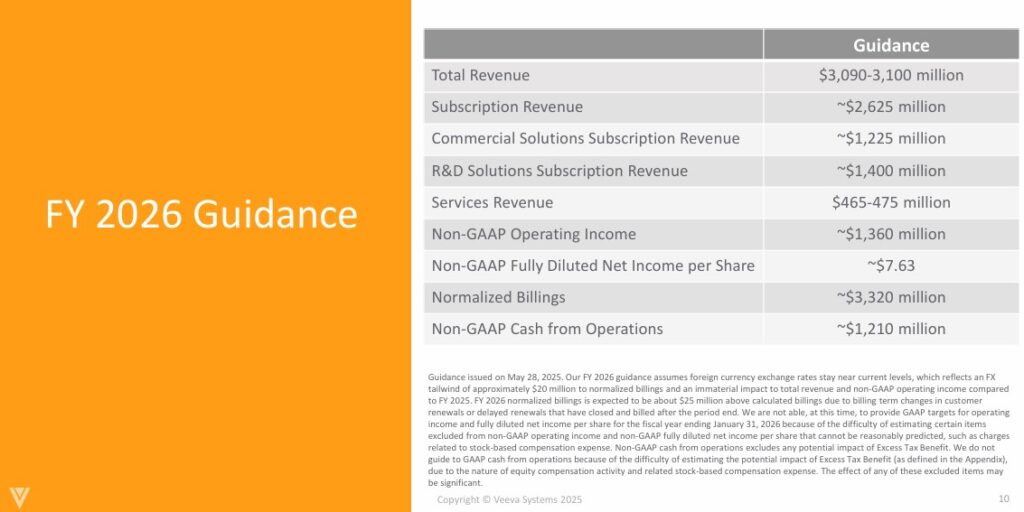Contents
 When I last reviewed Veeva Systems (VEEV) in this May 29, 2025 post, I concluded that the company’s valuation was no longer a bargain. At the time of that post, the most recent financial results were for Q1 2026. With the release of Q2 and YTD2026 results following the August 27 market close, let’s revisit VEEV’s valuation.
When I last reviewed Veeva Systems (VEEV) in this May 29, 2025 post, I concluded that the company’s valuation was no longer a bargain. At the time of that post, the most recent financial results were for Q1 2026. With the release of Q2 and YTD2026 results following the August 27 market close, let’s revisit VEEV’s valuation.
Business Overview
VEEV is the leading provider of industry cloud solutions for the global life sciences industry. Its offerings span cloud software, data, and business consulting and are designed to meet customers’ unique needs and their most strategic business functions ranging from R&D through commercialization. These solutions help life sciences companies develop and bring products to market faster and more efficiently, market and sell more effectively, and maintain compliance with government regulations.
The best way to learn about the company is to review the company’s website and Part 1 in the most recent Form 10-K found in the SEC Filings section of the company’s website.
In 2019, VEEV set an ambitious target of achieving $3B of annual revenue by 2025. It has already reached this target.
Building on this foundation and the strong start to FY2026, VEEV’s new ambitious target is to double revenue to $6B by FY2030.
Resolution of IQVIA Litigation Matters
Details of these litigation matters are found in VEEV’s Q1 2026 Form 10-Q on pages 15 and 31 of 62.
On August 18, 2025, VEEV and IQVIA (IQV) announced global clinical and commercial partnerships and the complete resolution of all pending legal disputes. Under the terms of the long-term agreement, customers can use software, data, technology, and service offerings from both companies together in a simple and efficient way.
Financial Review
Q2 and YTD2026
Material related to the Q2 and YTD2026 earnings release (including management’s prepared remarks) is accessible here.
Operating Cash Flow (OCF), Free Cash Flow (FCF), and CAPEX
VEEV reports the following annual OCF over the past few years. The current FY2026 guidance calls for ~$1.33B of OCF and a non-GAAP OCF margin of 42%. The previous guidance, released with Q1 2026 results on May 28, 2025, was ~$1.21B and 39%.

VEEV deducts CAPEX from OCF to calculate its FCF. In prior posts, however, I explain my rationale for also deducting share-based compensation (SBC) from a company’s OCF.
The following reflects VEEV’s FCF using the conventional and modified methods. We see from the historical results that the magnitude VEEV’s SBC has a material impact on FCF/share.

In comparison, VEEV’s net cash provided by operating activities in the first half of FY2025 was ~$0.856B, CAPEX was ~$11.5 million, and the weighted average diluted shares outstanding was 164.497 million.
Q3 and FY2026 Outlook
The following reflects VEEV’s current and prior outlook. All metrics have been guided higher each quarter.


The following reflects VEEV’s outlook released with Q1 2026 results.


The following reflects VEEV’s outlook released with Q4 2025 results.


Risk Assessment
VEEV has no debt to rate.
At the end of Q2 2026, VEEV had ~$1.93B in cash and cash equivalents and ~$4.473B in short-term investments for a total of ~$6.403B. In comparison, it had:
- ~$1.965B and ~$4.103B for a total of ~$6.068B at the end of Q1 2026;
- ~$1.119B and ~$4.031B for a total of ~$5.15B at FYE2025; and
- ~$0.703B and ~$3.324B for a total of ~$4.027B at FYE2024.
Its total liabilities at the end of Q2 2026 was ~$1.361B of which ~$1.108B was deferred revenue (funds received from clients in advance of services being provided) leaving ~$0.253B in all other liabilities. In comparison, it had:
- ~$1.554B in total liabilities of which ~$1.246B was deferred revenue leaving ~$0.308B in all other liabilities at the end of Q1 2026;
- ~$1.507B in total liabilities of which ~$1.274B was deferred revenue leaving ~$0.233B in all other liabilities at FYE2025; and
- ~$1.266B in total liabilities of which ~$1.050B was deferred revenue leaving ~$0.216B in all other liabilities at FYE2024.
VEEV satisfies my risk-averse investor profile.
Dividends and Dividend Yield
VEEV does not distribute a dividend.
The weighted average number of diluted shares outstanding (in millions rounded) in FY2021 – 2025 is 160.7, 162.2, 162.4, 163.5, and 165.2. The weighted average in the first half of FY2026 was 167.3.
If I have one concern about VEEV, it is the extent to which it compensates employees by way of SBC. VEEV typically does not repurchase shares to offset the shares it issues annually as part of its employee compensation structure. I think VEEV will, at some point, need to address the increase in the weighted average number of diluted shares outstanding. Until such time as share repurchases form part of VEEV’s capital allocation strategy, I am satisfied that funds be retained in the company to finance growth.
Valuation
Valuation Based On FCF Estimates
The company’s FY2026 Non-GAAP Fully Diluted Net Income per Share outlook is ~$7.78. The non-GAAP and GAAP diluted EPS values in FY2022 – FY2025 reflect an increasing variance between GAAP and non-GAAP earnings.
- In FY2025, VEEV generated $6.60 and $4.32 of non-GAAP and GAAP earnings per share, a variance of $2.28.
- In FY2024, VEEV generated $4.84 and $3.22 of non-GAAP and GAAP earnings per share, a variance of $1.62.
- In FY2023, VEEV generated $4.28 and $3.00 of non-GAAP and GAAP earnings per share, a variance of $1.28.
- In FY2022, VEEV generated $3.73 and $2.63 of non-GAAP and GAAP earnings per share, a variance of $1.10.
In the first half of FY2025, VEEV generated $3.12 and $2.02 of non-GAAP and GAAP earnings per share, a variance of $1.10. In comparison, VEEV generated $3.96 and $2.56 of non-GAAP and GAAP earnings per share (a $1.40 variance) in the first half of FY2026.
If the variance in the second half of FY2026 is similar to that in the first half, the variance for the entire year could be ~$2.80. Deduct ~$2.80 from the ~$7.78 FY2026 non-GAAP outlook and the FY2026 GAAP EPS could be ~$4.98.
If we apply a 140% FCF to net earnings ratio (to be somewhat consistent with prior years), VEEV’s FCF/share could be ~$6.97 (~$4.98 x 140%) when calculated under the conventional method.
If we apply a 95% FCF to net earnings ratio (to be somewhat consistent with prior years), VEEV’s FCF/share would be ~$4.73 (~$4.98 x 95%) when calculated under the modified method.
With shares trading at ~$278 as I compose this post, VEEV’s P/FCF is ~40 if we use ~$6.97 or ~58.8 if we use ~$4.73.
At the time of my May 29, 2025 post, VEEV’s share price was ~$279. My calculations suggested that VEEV’s forward P/FCF was ~39.5 and ~66.6 calculated using the conventional and modified FCF.
Valuation Based On Adjusted Diluted EPS Broker Estimates
Broker earnings estimates are currently under revision. At the moment, however, the following are VEEV’s forward adjusted diluted PE levels using the current broker estimates and a ~$278 share price.
- FY2026 – 30 brokers – mean of $7.75 and low/high of $7.62 – $7.93. Using the mean estimate, the forward adjusted diluted PE is ~35.9.
- FY2027 – 30 brokers – mean of $8.42 and low/high of $7.55 – $8.96. Using the mean estimate, the forward adjusted diluted PE is ~33.
- FY2028 – 18 brokers – mean of $9.66 and low/high of $8.24 – $13.78. Using the mean estimate, the forward adjusted diluted PE is ~28.8.
At the time of my May 29, 2025 post, the following were VEEV’s forward adjusted diluted PE levels using the current broker estimates and a ~$279 share price.
- FY2026 – 29 brokers – mean of $7.50 and low/high of $7.17 – $7.76. Using the mean estimate, the forward adjusted diluted PE is ~37.2.
- FY2027 – 29 brokers – mean of $8.24 and low/high of $7.58 – $8.69. Using the mean estimate, the forward adjusted diluted PE is ~33.9.
- FY2028 – 12 brokers – mean of $9.38 and low/high of $8.56 – $10.10. Using the mean estimate, the forward adjusted diluted PE is ~29.7.
Final Thoughts
VEEV ‘checks several boxes’ for me in that management’s target is to double revenue to $6B by FY2030 and is likely to remain debt free.
I currently hold 500 shares at an average cost of $207.2545 in the FFJ Portfolio. It was my 24th largest holding when I completed my 2025 Mid-Year Portfolio Review.
In hindsight, I should have been adding to my exposure in April/May but I can add my failure to do so to my very long list of errors of omission.
Shares appear to be fairly valued in the ~$275 – ~$280 range. I prefer to acquire shares in undervalued companies, and therefore, am refraining from immediately adding to my VEEV exposure.
I wish you much success on your journey to financial freedom!
Note: Please send any feedback, corrections, or questions to finfreejourney@gmail.com.
Disclosure: I am long VEEV.
Disclaimer: I do not know your circumstances and do not provide individualized advice or recommendations. I encourage you to make investment decisions by conducting your own research and due diligence. Consult your financial advisor about your specific situation.
I wrote this article myself and it expresses my own opinions. I do not receive compensation for it and have no business relationship with any company mentioned in this article.

